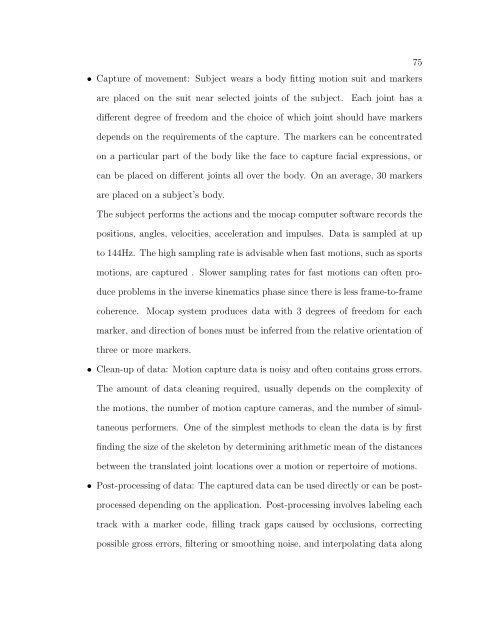A COMPARISON AND EVALUATION OF MOTION INDEXING ...
A COMPARISON AND EVALUATION OF MOTION INDEXING ...
A COMPARISON AND EVALUATION OF MOTION INDEXING ...
Create successful ePaper yourself
Turn your PDF publications into a flip-book with our unique Google optimized e-Paper software.
• Capture of movement: Subject wears a body fitting motion suit and markers<br />
are placed on the suit near selected joints of the subject. Each joint has a<br />
different degree of freedom and the choice of which joint should have markers<br />
depends on the requirements of the capture. The markers can be concentrated<br />
on a particular part of the body like the face to capture facial expressions, or<br />
can be placed on different joints all over the body. On an average, 30 markers<br />
are placed on a subject’s body.<br />
The subject performs the actions and the mocap computer software records the<br />
positions, angles, velocities, acceleration and impulses. Data is sampled at up<br />
to 144Hz. The high sampling rate is advisable when fast motions, such as sports<br />
motions, are captured . Slower sampling rates for fast motions can often pro-<br />
duce problems in the inverse kinematics phase since there is less frame-to-frame<br />
coherence. Mocap system produces data with 3 degrees of freedom for each<br />
marker, and direction of bones must be inferred from the relative orientation of<br />
three or more markers.<br />
• Clean-up of data: Motion capture data is noisy and often contains gross errors.<br />
The amount of data cleaning required, usually depends on the complexity of<br />
the motions, the number of motion capture cameras, and the number of simul-<br />
taneous performers. One of the simplest methods to clean the data is by first<br />
finding the size of the skeleton by determining arithmetic mean of the distances<br />
between the translated joint locations over a motion or repertoire of motions.<br />
• Post-processing of data: The captured data can be used directly or can be post-<br />
processed depending on the application. Post-processing involves labeling each<br />
track with a marker code, filling track gaps caused by occlusions, correcting<br />
possible gross errors, filtering or smoothing noise, and interpolating data along<br />
75
















